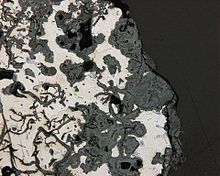- Selective leaching
-
Selective leaching, also called dealloying, demetalification, parting and selective corrosion, is a corrosion type in some solid solution alloys, when in suitable conditions a component of the alloys is preferentially leached from the material. The less noble metal is removed from the alloy by microscopic-scale galvanic corrosion mechanism. The most susceptible alloys are the ones containing metals with high distance between each other in the galvanic series, eg. copper and zinc in brass. The elements most typically undergoing selective removal are zinc, aluminium, iron, cobalt, chromium, and others.
Contents
Leaching of zinc
"DZR" redirects here. For the jujutsu school, see Danzan-ryū.The most common example is selective leaching of zinc from brass alloys containing more than 15% zinc (dezincification) in presence of oxygen and moisture, eg. from brass taps in chlorine-containing water. It is believed that both copper and zinc gradually dissolved out simultaneously and copper precipitates back from the solution. The material remaining is a copper-rich sponge with poor mechanical properties, and color changed from yellow to red. Dezincification can be caused by water containing sulfur, carbon dioxide and oxygen. Stagnant or low velocity waters tend to promote dezincification.
To combat this, arsenic or tin can be added to brass, or gunmetal can be used instead. Dezincification resistant brass (DZR) is an alloy used to make pipe fittings for use with potable water. Plumbing fittings that are resistant to dezincification are appropriately marked, with the letters "CR" (Corrosion Resistant) or DZR (dezincification resistant) in the UK, and the letters "DR" (dezincification resistant) in Australia.
Graphitic corrosion
Graphitic corrosion is selective leaching of iron from grey cast iron, where iron gets removed and graphite grains remain intact. Affected surfaces develop a layer of graphite, rust, and metallurgical impurities that may inhibit further leaching. The effect can be substantially reduced by alloying the cast iron with nickel.[1]
Leaching of other elements
Dealuminification is a corresponding process for aluminum alloys. Similar effects for different metals are decarburization (removal of carbon from the surface of alloy), decobaltification, denickelification, etc.
Countermeasures
Countermeasures involve using alloys not susceptible to grain boundary depletion, using a suitable heat treatment, altering the environment (eg. lowering oxygen content), and/or use cathodic protection.
Uses
Selective leaching can be used to produce powdered materials with extremely high surface area, such as Raney nickel. Selective leaching can be the pre-final stage of depletion gilding.
References
- ^ Don W. Green and James O. Maloney, eds. Perry's Chemical Engineers' Handbook. 7th ed., 1997.
External links
Categories:- Corrosion prevention
- Corrosion
Wikimedia Foundation. 2010.


